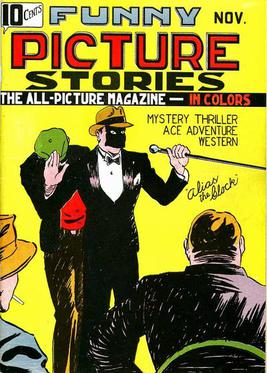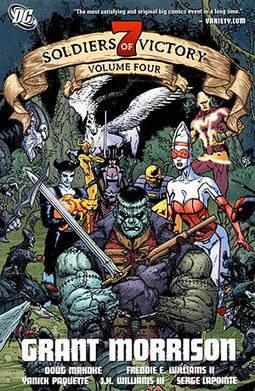Related Research Articles

Starman is a name used by several different DC Comics superheroes, most prominently Ted Knight and his sons David and Jack.

Starman is fictional superhero in the DC Comics Universe and a member of the Justice Society of America. He is the son of the original Starman, Ted Knight. Created by James Robinson and Tony Harris, he first appeared in Zero Hour #1.
The Injustice Society is a group of supervillains in the DC Comics Universe. They are the main antagonists of the Justice Society of America.

The Seven Soldiers of Victory is a team of fictional comic book superheroes in the DC Comics universe. They first appeared in Leading Comics #1, and were created by Mort Weisinger and Mort Meskin. The team was a short-lived assembly of some of the less famous superheroes in the DC Universe who have made occasional appearances since their Golden Age debut.

The Shade is a comic book character developed in the 1940s for National Comics, first appearing in the pages of Flash Comics in a story titled "The Man Who Commanded the Night", scripted by Gardner Fox and illustrated by Hal Sharp. Debuting as a villain, the Shade was best known for fighting against two generations of superheroes, most notably the Golden Age and Silver Age versions of the Flash. He eventually became a mentor for Jack Knight, the son of the Golden Age Starman, Ted Knight, a hero the Shade had also fought.

Bulletman and Bulletgirl are fictional superheroes originally published by Fawcett Comics.
Vigilante is the name used by several fictional characters appearing in American comic books published by DC Comics. Notable individuals to assume the alias include Greg Saunders and Adrian Chase.

The Clock is a fictional masked crime-fighter character created in 1936, during the Golden Age of Comic Books. He was the first fully-masked hero to appear in American comic books.

Bulleteer is a fictional character and DC Comics superheroine, a member of the Seven Soldiers. She debuted in Seven Soldiers: The Bulleteer #1, and was created by Grant Morrison and Yanick Paquette. The character is based in part on the Fawcett Comics character Bulletgirl.

The Electrocutioner is an alias used by three fictional characters in the DC Universe, all minor enemies of the superhero Batman.

Prince Ra-Man is a fictional comic book magician published by DC Comics. Mark Merlin first appeared in House of Secrets #23, and was created by Mort Meskin. Prince Ra-Man first appeared in House of Secrets #73, and was created by Jack Miller and Bernard Baily.

Seven Soldiers is a 2005–2006 comic book metaseries written by Grant Morrison and published by DC Comics. It was published as seven interrelated mini-series and two bookend issues. The series features a new version of the Seven Soldiers of Victory fighting to save Earth from the Sheeda. The series has been interpreted as "an extended metafictional treatise on the writing and reading of comic books in general and the superhero genre in particular".

Frankenstein is a fictional character appearing in American comic books published by DC Comics. He is based on the Frankenstein's monster character created by Mary Shelley.

Congorilla, originally a human character known as Congo Bill, is a superhero appearing in comic books published by DC Comics and Vertigo Comics. Originally co-created by writer Whitney Ellsworth and artist George Papp, he was later transformed into Congorilla by Robert Bernstein and Howard Sherman. The character first appeared in More Fun Comics #56.

The Invisible Hood is a fictional superhero in the DC Comics Universe. He was originally owned by Quality Comics, but was later acquired by DC Comics, along with other Quality characters. He first appeared in Smash Comics #1, and was created by Art Pinajian, who illustrated the story under the pseudonym "Art Gordon".

Robotman is a Golden Age DC Comics superhero. He first appeared in Star Spangled Comics #7 and was created by Jerry Siegel and Leo Nowak. As his name suggests, Robotman is a cyborg; part robot and part human.
The Whip is the alias used by different characters in DC Comics with four of them being superheroes. The third one made his first appearance in Flash Comics #1. The fourth Whip appeared in 2005 and was created by Grant Morrison. The fifth Whip appeared in 2011 and was created by Fabian Nicieza.
Scalphunter is a fictional character, a Wild West hero in the DC Comics Universe. Scalphunter first appeared in Weird Western Tales #39 and was created by Sergio Aragones and Joe Orlando.

Greg Saunders is a superhero appearing in American comic books published by DC Comics. He is the first DC character to bear the name Vigilante.
References
- ↑ Wallace, Dan (2008), "Alias the Spider", in Dougall, Alastair (ed.), The DC Comics Encyclopedia, London: Dorling Kindersley, p. 10, ISBN 978-0-7566-4119-1
- ↑ Koolman, Mike; Amash, Jim (2011). The Quality Companion. TwoMorrows Publishing. pp. 185–187. ISBN 978-1605490373.
- ↑ Markstein, Don. "Alias the Spider". Don Markstein's Toonopedia. Retrieved 18 March 2020.
- ↑ Nevins, Jess (2013). Encyclopedia of Golden Age Superheroes. High Rock Press. p. 251. ISBN 978-1-61318-023-5.
- ↑ DC's Harley Quin Romances #1. DC Comics.
- ↑ Detective Comics #36 (February 1940). DC Comics.
- ↑ Action Comics #35 (April 1941). DC Comics.
- ↑ All-American Comics #28 (July 1941). DC Comics.
- ↑ Star-Spangled Comics #40 (January 1945). DC Comics.
- ↑ Sensational Comics #38 (February 1945). DC Comics.
- ↑ Blackhawk #58 (November 1952). DC Comics.
- ↑ Plastic Man #46 (May 1954). Quality Comics.
- ↑ Wonder Woman #79 (January 1956). DC Comics.
- ↑ Catwoman Vol. 2 #48 (August 1997). DC Comics.
- ↑ Arkham Manor #2 (January 2015). DC Comics.